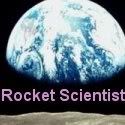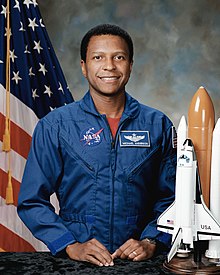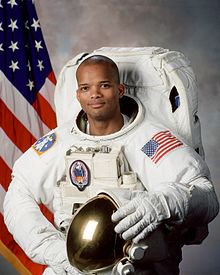Repost: Some of our African American Astronauts
>> Wednesday, February 11, 2015
Report from former blog:
As a departure from the tragedies of the past week, I
would like to embrace and celebrate Black History Month. In fact, I’m
all for celebrating the achievements of people at any opportunity.
I am not black and, to the best of my knowledge, I
have no black ancestry. It wouldn’t bother me if that were not the
case, but, there it is. However, I would like to take the opportunity
to celebrate the achievements and accomplishments of those of African or
Aboriginal (would some Asian races qualify? Could someone clarify
this?) throughout the world and throughout history. I think it will be a
journey for me, since Africa is perhaps the continent I know the least
about. I do want to know more.
This is an opportunity for me and I hope you enjoy the journey since I intend to share it with you.
In keeping with my rocket scienciness, I’m going to start by telling you about some of NASA’s African American astronauts:
 On Challenger, we lost another African-American astronaut, Ronald Ervin McNair
, Ph.D. Another physicist, with a Ph.D. from MIT, Dr. McNair was a
well-rounded individual with a fifth degree black belt in karate who
happened to play the saxophone [Ed: musical talent is actually fairly
common among the astronauts]. Recruited by NASA by actress Nichelle
Nichols (of the original Star Trek fame), he flew on STS-41B in February
1984 (also on Challenger) where he played the saxophone for posterity.
He flew again, briefly, on STS-51L and perished with his crew on
January 28, 1986.
On Challenger, we lost another African-American astronaut, Ronald Ervin McNair
, Ph.D. Another physicist, with a Ph.D. from MIT, Dr. McNair was a
well-rounded individual with a fifth degree black belt in karate who
happened to play the saxophone [Ed: musical talent is actually fairly
common among the astronauts]. Recruited by NASA by actress Nichelle
Nichols (of the original Star Trek fame), he flew on STS-41B in February
1984 (also on Challenger) where he played the saxophone for posterity.
He flew again, briefly, on STS-51L and perished with his crew on
January 28, 1986. Robert H. Lawrence, Jr . (Ph.D.) was actually the first African-American to be accepted into the astronaut corps. With a Ph.D. in Physical Chemistry and a background as a test pilot, he was well qualified to become an astronaut, and was accepted into the astronaut corps in June 1967. However, a tragic accident during a training flight with him as instructor ended in his death only months after joining the program.
 Guion “Guy” Bluford, Jr. (Ph.D) is the first African American*
to go into space. With a Ph.D. in aerospace engineering (and a minor
in laser physics), 144 combat missions of flying experience in Vietnam,
he became an astronaut in 1979. He first flew on STS-8 in 1983, then
flew three other missions, STS-61A in 1985, STS-39 in 1991, and STS-53
in 1992. He retired from the astronaut corps in 1993.
Guion “Guy” Bluford, Jr. (Ph.D) is the first African American*
to go into space. With a Ph.D. in aerospace engineering (and a minor
in laser physics), 144 combat missions of flying experience in Vietnam,
he became an astronaut in 1979. He first flew on STS-8 in 1983, then
flew three other missions, STS-61A in 1985, STS-39 in 1991, and STS-53
in 1992. He retired from the astronaut corps in 1993.Charles F. Bolden, Jr . was a naval aviator that flew more than 100 sorties into North and South Vietnam, Laos, and Cambodia, in the A-6A Intruder during the Vietnam war. Impressive enough credentials, one might think, even without the degrees in electrical science and systems management. NASA thought so too and accepted him into the astronaut corps in 1980. Between that and his retirement from the corps in 1994, he served as pilot on two missions: STS-61C in 1986, STS-31 in 1990 (Hubble Space Telescope launch) and commanded two other missions: STS-45 (first SpaceLab mission) and STS-60 (the first joint US/Russian Shuttle mission). He is now the Director for ALL of NASA.

Yvonne Darlene Cagle is a medical doctor and female astronaut currently assigned to the Life Sciences Directorate at JSC. Apparently, she likes to write historical novels. How cool is that?
Robert Lee Curbeam, Jr . joined the astronaut corps in 1994, another naval aviator with degrees in aerospace and aeronautical engineering, he has flown on three missions: STS-85 in 1997, STS-98 in 2001 and STS-116. On STS-116 he set the record for the most spacewalks (EVAs) on one flight - four. EVA takes a great deal out of one, so that’s no mean achievement. I happen to have worked with Mr. Curbeam and it was a real pleasure - he’s talented, intelligent, pleasant and a pleasure to work with. He announced his retired from the astronaut corps in 2007.
 B. Alvin Drew
is a Command Pilot with 3000 hours flying time in over 30 types of
aircraft, including helicopters and fighter craft for both rescue and
combat missions in the middle East. He also has degrees in both physics
and aeronautical engineering. Selected for the astronaut corps in 200,
he has flown one mission, STS-118 in 2007.
B. Alvin Drew
is a Command Pilot with 3000 hours flying time in over 30 types of
aircraft, including helicopters and fighter craft for both rescue and
combat missions in the middle East. He also has degrees in both physics
and aeronautical engineering. Selected for the astronaut corps in 200,
he has flown one mission, STS-118 in 2007.But, wait, there’s more. And tomorrow I’ll include the rest of the African American astronauts. Note that the links are generally to Wikipedia because they link to many other useful places. Revel a bit in the talent NASA has drawn.
*The first person of African descent in space was actually a Cuban cosmonaut, Arnaldo Tamayo Méndez . Recruited from the Cuban Air Force through the Soviet Intecosmos program, he was launched on Soyuz 38 with Yuri Romanenko to rendezvous with Salyut 6 on orbit in 1980.









.jpg)











.jpg)



0 comments:
Post a Comment